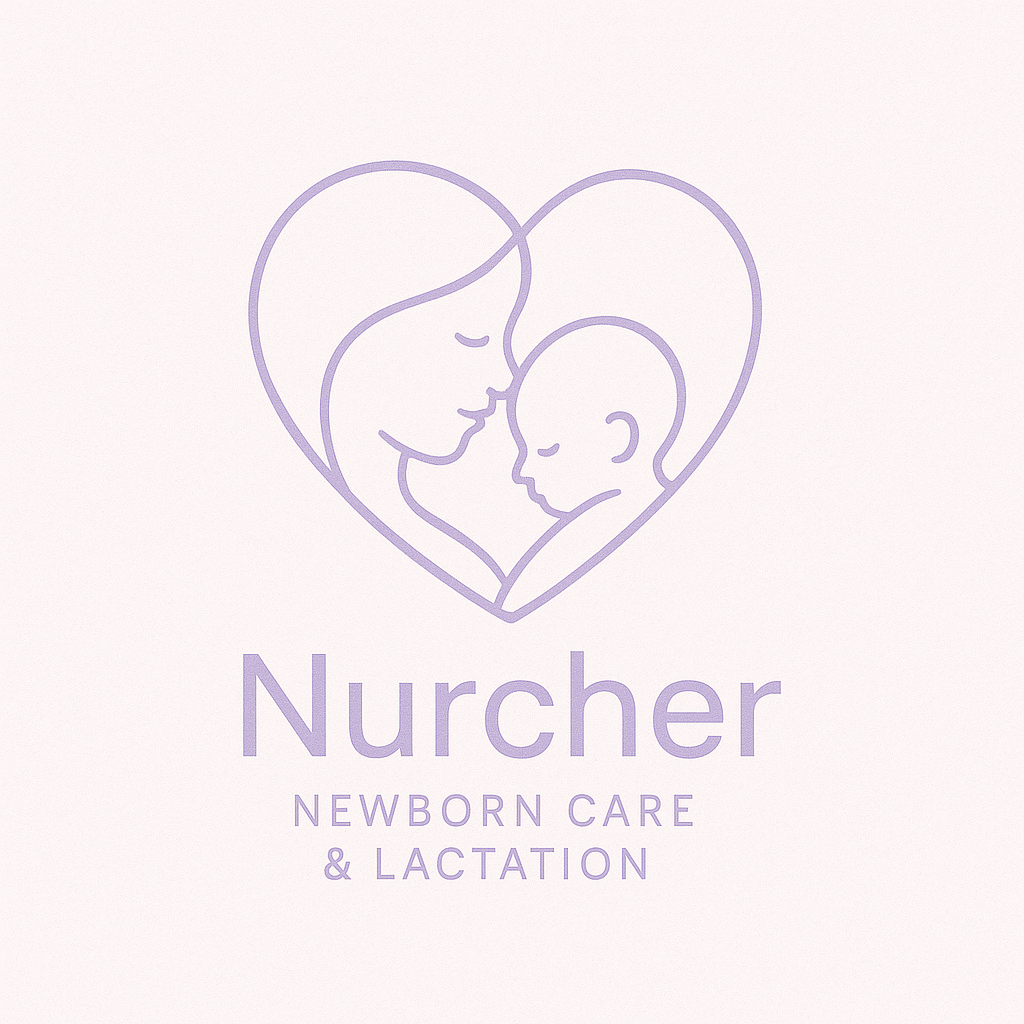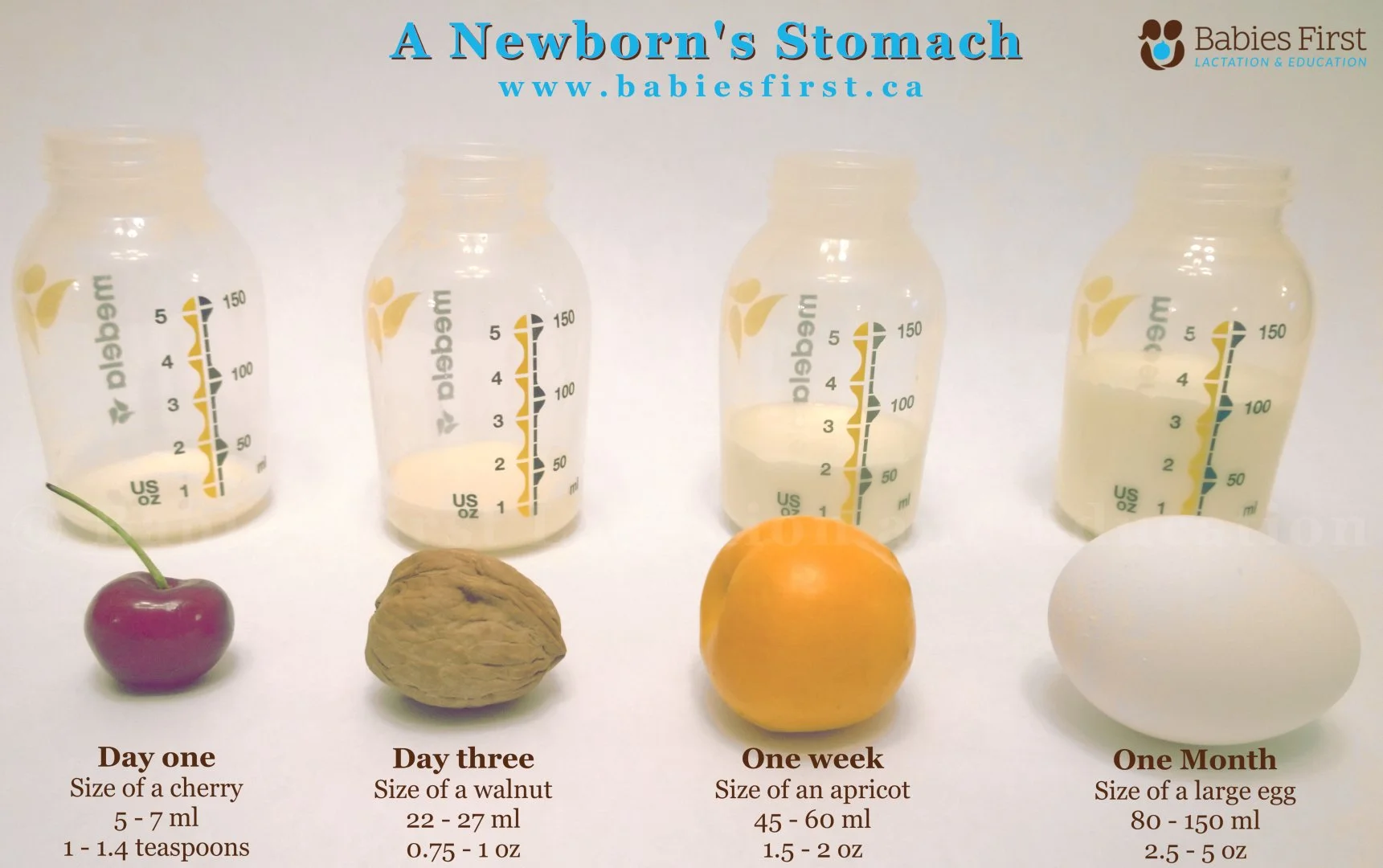Your First Feeding Guide: What to Know About Breastfeeding, Bottle Feeding & Baby’s Tiny Tummy
Your Baby’s Stomach is Tiny—and Growing Fast
It can be helpful (and relieving!) to know just how small a newborn's stomach really is:
Knowing this can ease so many fears: your baby is not meant to take large amounts at first—their tummy simply can’t hold it! That’s why they feed frequently, even hourly at times. It’s not a sign you aren’t producing enough—it’s a sign your baby’s body and your body are working in perfect partnership.
Feeding on Demand: Trusting Your Baby’s Cues
In the early weeks, feeding on demand—or responsive feeding—means offering the breast (or bottle) whenever your baby shows signs of hunger. This can look like:
Rooting or turning their head toward your chest
Sucking on hands
Smacking or licking lips
Stirring, stretching, or starting to fuss
Crying is actually a late hunger cue—so if you catch the early signs, feedings tend to go more smoothly.
Feeding on demand helps your baby get exactly what they need, when they need it, and also signals your body to produce just the right amount of milk.
Newborns rarely feed on a strict schedule—sometimes they’ll want to nurse again after just 20 minutes, other times they may sleep for a longer stretch. This is all very normal and healthy.
What About Cluster Feeding?
If it feels like your baby wants to nurse or take a bottle every hour—or even more—you’re not alone. This is something called cluster feeding, and it’s completely normal (though it can feel exhausting in the moment!). Babies often cluster feed during the early evening hours or during growth spurts, when they naturally want more frequent feeds to boost your milk supply or meet their growing needs.
While cluster feeding can make you question if your baby is getting enough, it’s usually a healthy sign that your baby is following their instincts. Just follow their lead, offer the breast or bottle when they cue for it, and remind yourself: this phase is temporary. Many babies settle back into longer stretches between feeds after a few days.
How Do I Know My Baby Is Getting Enough?
One of the most common concerns new parents share with me is: "How do I know if my baby is eating enough?" or "Why does my baby want to feed so often?" These are such valid and normal worries, and I want to gently reassure you: newborn feeding patterns are beautifully designed for their tiny bodies—and your body’s milk supply. Thankfully, your baby gives helpful clues when they are getting enough:
Wet & Dirty Diapers:
In the first few days, expect at least 1 wet diaper per day of life (1 on day 1, 2 on day 2, etc.).
After day 4-5, your baby should have at least 6 wet diapers and 3-4 yellow, seedy poops every 24 hours if breastfeeding.
Formula-fed babies may have slightly fewer bowel movements.
Weight Gain:
It’s normal for babies to lose up to 7-10% of their birth weight in the first few days.
By about 2 weeks old, most babies regain their birth weight.
After that, babies typically gain 5-7 ounces per week in the first few months.
If your baby is meeting these diaper and weight milestones, feeding frequently, and seems generally content between feeds, it’s a good sign they’re getting plenty to eat—even if they cluster feed or feed at odd times. Always trust your instincts and reach out to your care team or lactation consultant if you have concerns—they’re there to support you.
Should I Wake My Baby to Feed?
In the early days, when your baby is still working to regain their birth weight, it’s important to offer regular feeds—even if that means waking them. Most newborns need to eat at least every 2–3 hours (measured from the start of one feed to the start of the next), including overnight, until they are back to their birth weight and gaining well.
While it can feel hard to wake a sleepy baby, these frequent feeds help ensure your baby stays hydrated, maintains stable blood sugars, and stimulates a good milk supply if breastfeeding. Some gentle ways to rouse a sleepy newborn include:
Unwrapping or undressing them down to a diaper
Skin-to-skin contact
Gently tickling their feet or stroking their cheek
Changing their diaper before feeding
Once your baby has regained their birth weight and your pediatrician or lactation consultant confirms they are feeding and growing well, you can usually let them wake on their own for feeds. Every baby is different, so if you’re unsure when to stop waking your baby, check with your healthcare provider for guidance tailored to your little one.
How to Bottle Feed Your Newborn (Including Paced Bottle Feeding)
Whether you are offering breastmilk, formula, or a mix of both, bottle feeding can be a loving, responsive way to nourish your baby. How you offer the bottle matters just as much as what’s inside, and using a technique called paced bottle feeding can help mimic breastfeeding, support healthy feeding cues, and prevent overfeeding.
What is Paced Bottle Feeding?
Paced bottle feeding encourages your baby to stay in control of the feeding, taking breaks as needed—just like at the breast. This method can help reduce gas, spit-up, and fussiness, and is especially helpful for breastfed babies who are also bottle fed, to reduce bottle preference.
Steps for Paced Bottle Feeding:
Hold your baby upright—keep them sitting at about a 45-degree angle rather than lying flat.
Offer the bottle horizontally—keep the bottle nearly parallel to the floor so the milk flows slowly.
Let your baby latch onto the bottle rather than pushing it into their mouth. Gently rub the nipple on their lips until they open wide.
Pause frequently—every few minutes, tip the bottle down or remove it to give your baby a break and allow them to decide if they want more.
Watch for cues—stop the feed when your baby shows signs of fullness like turning away, pushing the bottle out, or slowing their sucking.
General Bottle Feeding Tips:
Always hold your baby for feeds. Propping bottles is not safe and can increase the risk of choking or ear infections.
Let your baby set the pace—don’t rush or encourage them to finish the whole bottle if they show they’re full.
Use slow-flow nipples to help control milk flow.
Burp often—pause during and after feeds to help release swallowed air.
Responsive, paced bottle feeding supports your baby's natural appetite, protects your milk supply if you're also breastfeeding, and keeps feeding a calm, positive experience for both of you.
The Power of Skin-to-Skin for Feeding
One of the simplest, most natural ways to support your baby’s feeding journey is through skin-to-skin contact—holding your baby against your bare chest. This special closeness is powerful for so many reasons, especially when it comes to feeding.
For Breastfeeding:
Skin-to-skin helps your baby use their natural instincts to find the breast, latch more effectively, and feed more calmly. It also helps your body respond by releasing oxytocin—the hormone that encourages milk flow (let-down) and boosts milk production. Babies held skin-to-skin often breastfeed more frequently and effectively, which can make a big difference in establishing your milk supply.
For Bottle Feeding:
Skin-to-skin isn't just for breastfeeding! If you’re bottle feeding, holding your baby close, bare chest to bare chest, can help mimic the warmth and connection of breastfeeding. This can make feeds feel soothing and familiar for your baby, helping them stay calm and focused during feeding times.
Other Amazing Benefits:
Helps regulate your baby’s temperature, heart rate, and breathing
Reduces stress—for both baby and parent
Promotes bonding and attachment
May improve digestion and blood sugar stability
Whether you breastfeed, bottle feed, or do a combination, skin-to-skin time is a simple but beautiful way to support feeding and nurture your baby’s development. Even a few minutes can make a difference.
Final Thoughts
Feeding your newborn—whether by breast, bottle, or a combination of both—is a journey filled with learning, patience, and love. Remember, there’s no one “right” way to feed your baby—only the way that works best for you and your little one. Every baby is unique, and so is every feeding journey.
If you ever feel uncertain or have questions, don’t hesitate to reach out for support. You deserve to feel confident and empowered as you nourish your baby. You’re doing a wonderful job—and your baby is so lucky to have you.




